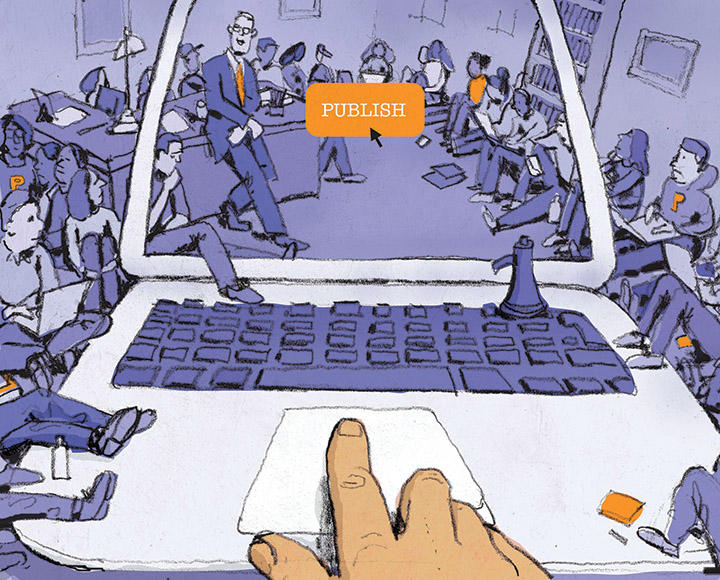Providing the World With an Inside View of the Nassau Hall Sit-In — in Real Time
After the doors of Nassau Hall were locked at 5 p.m. on Nov. 18, the first day of the sit-in by the Black Justice League, no more students were allowed to enter President Eisgruber ’83’s office. Those who had left couldn’t return, and fewer than 20 students remained inside. But thanks to the University Press Club’s “live blog” — written by a member embedded with the protesters in 1 Nassau Hall — students, administrators, and the public could feel as if they also had a seat inside as the protest unfolded.
The live blog consisted of brief, time-stamped updates from inside the president’s office, ranging from rapid-fire exchanges between Eisgruber and the demonstrators to more mundane moments, as when the office printer jammed just as the president was set to sign the agreement that ended the protest.
Gabe Fisher ’17 was the primary contributor to the blog, joining the group of protesters in Eisgruber’s office just minutes before the doors were locked — the only journalist in the room through the end of the sit-in. Other Press Club members had been in the office earlier, and continued to file updates on protest-related events outside Nassau Hall.
Fisher quickly chose the live-blog style of reporting: The constant, short updates satisfy the desire for immediacy that readers have in the digital age, he said, and the Press Club’s live blogs — usually of less serious events, like the final desperate hours before Dean’s Date — have been among the group’s most-read posts.
As candid moments like the printer jam were reported, the blog illustrated that despite the dramatic, sensational quality that the protests had to outsiders, things in the room were still relatively normal, and bounded by the same inconveniences of everyday life.
“In the role of students, we’re able to cover these nationally important events,” Fisher said, “but it’s also an attempt to cover these people not just as protesters or radical activists, but also as college students.”
Esther Maddox ’17, a Black Justice League member who took part in the sit-in, said the group was uncertain at first what it would be like to “work constantly with the public’s eye on our backs.” But the protesters felt the blog ultimately portrayed the events of the sit-in respectfully and accurately, she said, and helped speed the process of reaching an agreement with Eisgruber. “Without it, I think the reaction to what was happening would have been much slower,” she said.
Early on, the Black Justice League asked all reporters to identify themselves, Maddox said. (Other journalists were present as the sit-in began, but all except Fisher left by 9 p.m. the first night.) “The journalists respected our space and understood when it was appropriate for them to be observing and reporting the events that were developing, and when it was time for them to step out and allow us to work,” she said.
Both on and off campus, readers said the blog provided real-time access to the protest and the discussions that ultimately led to an agreement. Even Eisgruber acknowledged that his staff was reading the blog because it was the only way to know what was happening inside his office while he was gone.
After the sit-in was over, Fisher pitched his story to a former Press Club member who had covered a protest in Nassau Hall during his time at Princeton: New Yorker editor-in-chief David Remnick ’81. The result was an article by Fisher for the magazine’s website.
But Fisher downplayed the drama of the protest in an interview with PAW. “It didn’t feel like we were in a war zone at 2 in the morning on a Wednesday night,” he said. “It felt like we were a bunch of college students who had a lot of homework to do, who happened to be in the president’s office.”












No responses yet